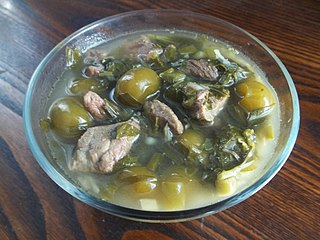
Seasoning is the process of adding salt, herbs, or spices to food to enhance the flavour.

In cooking, a sauce is a liquid, cream, or semi-solid food, served on or used in preparing other foods. Most sauces are not normally consumed by themselves; they add flavor, moisture, and visual appeal to a dish. Sauce is a French word taken from the Latin salsa, meaning salted. Possibly the oldest recorded European sauce is garum, the fish sauce used by the Ancient Greeks; while doubanjiang, the Chinese soy bean paste is mentioned in Rites of Zhou in the 3rd century BC.
Fines herbes designates an important combination of herbs that forms a mainstay of French cuisine. The canonic fines herbes of French haute cuisine comprise finely chopped parsley, chives, tarragon, and chervil. These are employed in seasoning delicate dishes, such as chicken, fish, and eggs, that need a relatively short cooking period; they may also be used in a beurre blanc sauce for seasoning such dishes. Fines herbes are also eaten raw in salads.

Chateaubriand steak is a meat dish cooked with a thick cut from the tenderloin filet. In contemporary times, chateaubriand cuts of beef refer to "a large steak cut from the thickest part of a fillet of beef".

Hollandaise sauce, formerly also called Dutch sauce, is an emulsion of egg yolk, melted butter, and lemon juice. It is usually seasoned with salt, and either white pepper or cayenne pepper.
Green sauce is a family of cold, uncooked sauces based on herbs, including the Spanish and Italian salsa verde, the French sauce verte, the German Grüne Soße or Frankfurter Grie Soß, and the Argentinian chimichurri.

Rémoulade is a condiment invented in France that is usually aioli- or mayonnaise-based. Although similar to tartar sauce, it is often more yellowish, sometimes flavored with curry, and sometimes contains chopped pickles or piccalilli. It can also contain horseradish, paprika, anchovies, capers and a host of other items. While its original purpose was possibly for serving with meats, it is now more often used as a condiment or dipping sauce, primarily for sole, plaice, and seafood cakes.

Béarnaise sauce is a sauce made of clarified butter emulsified in egg yolks and white wine vinegar and flavored with herbs. It is considered to be a "child" of the mother Hollandaise sauce, one of the five mother sauces in the French haute cuisine repertoire. The difference is only in the flavoring: Béarnaise uses shallot, chervil, peppercorns, and tarragon in a reduction of vinegar and wine, while Hollandaise is more stripped down, using a reduction of lemon juice or white wine. Its name is related to the province of Béarn, France.

A velouté sauce is a savoury sauce, made from a roux and a light stock. It is one of the five "mother sauces" of French cuisine listed by Auguste Escoffier in the 19th century, along with espagnole, tomato, béchamel and hollandaise. The term velouté is the French word for velvety.

Sauce américaine is a recipe from classic French cookery containing chopped onions, tomatoes, white wine, brandy, salt, cayenne pepper, butter and fish stock. It is sometimes known as sauce armoricaine, which is the original name, derived from Armorica, the ancient name for a region of France including Brittany, which is known for its fishing.

Georgian cuisine refers to the cooking styles and dishes created by the Georgians. The Georgian cuisine is unique to the country, but also carries some influences from other Caucasian, Eastern European and nearby Middle Eastern culinary traditions. Each historical province of Georgia has its own distinct culinary tradition, with variations such as Abkhazian, Megrelian, Kakhetian, Imeretian, Svanetian, Tushian, Kartlian, Gurian, Meskhian, Rachian and Adjarian cuisines. Rich with meat dishes, the Georgian cuisine also offers a variety of vegetarian dishes.
Sauce vierge is a French sauce made from olive oil, lemon juice, chopped tomato and chopped basil.

Chakapuli is a Georgian stew. It is considered to be one of the most popular dishes in Georgia.

Sauce gribiche is a mayonnaise-style cold egg sauce in the French cuisine, made by emulsifying hard-boiled egg yolks and mustard with a neutral oil like canola or grapeseed. The sauce is finished with chopped pickled cucumbers, capers, parsley, chervil and tarragon. It also includes hard-boiled egg whites cut in a julienne.

Paling in 't groen is a Flemish regional dish, mainly from the area along the River Scheldt between Dendermonde and Antwerp. The Dutch language name refers to freshwater eel in a green herb sauce. The traditionally home-made meal is also sold fully prepared but still uncooked by some fishmongers' shops or market stalls, and can be enjoyed in specialty restaurants.
The Dîner des trois empereurs or Three Emperors Dinner was a banquet held at Café Anglais in Paris, France on 7 June 1867. It consisted of 16 courses with eight wines served over eight hours.

Wine sauce is a culinary sauce prepared with wine as a primary ingredient, heated and mixed with stock, butter, herbs, spices, onions, garlic and other ingredients. Several types of wines may be used, including red wine, white wine and port wine. Some versions are prepared using a reduction. Several types of wine sauces exist, and it is used in many dishes, including those prepared with seafood, poultry and beef. Wine sauces are associated with French cuisine.

Beurre Maître d'Hôtel, also referred to as Maître d'Hôtel butter, is a type of compound butter of French origin, prepared with butter, parsley, lemon juice, salt and pepper. It is a savory butter that is used on meats such as steak, fish, vegetables and other foods. It may be used in place of a sauce, and can significantly enhance a dish's flavor. Some variations with a sweet flavor exist. It is usually served cold as sliced disks on foods, and is sometimes served as a side condiment.















